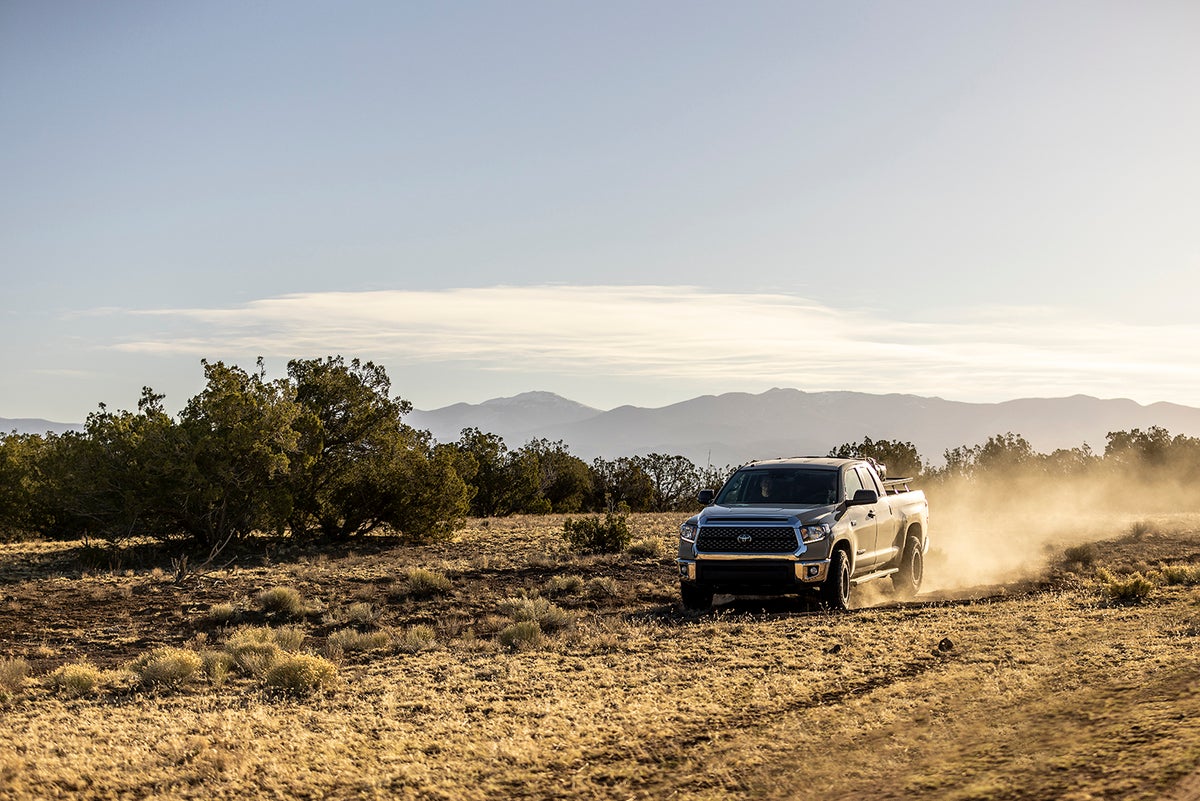
When you first start out overlanding, it can be easy to be overwhelmed with all the options and figure out which upgrades and gear are essential—and which are not. So we teamed up with Toyo Tires to create a guide to everything you need to know about overlanding. But veteran overlanders will tell you that the first and most important upgrade to your off-road-capable vehicle is a quality set of all-terrain tires. After that, you’re always going to be refining your set up, says overland enthusiast Richard Giordano (@desktoglory). “Our truck is in a constant state of flux, every time we go out we find something we want to change in order to better suit a particular climate or adventure.” But with a few key pieces of gear, you’ll be off to a good start.
Choose the Right Tires

“Tires are the single most important upgrade you can make to a vehicle when it comes to traction and puncture resistance for dirt roads and rocks,” says Rogala. Reinforced tires that provide better traction, and can be aired down for even more grip, open up an entire section of off-road trails for exploration. There are many tire models to choose from, but a longtime favorite among the overlanding community is the Toyo Open Country A/T III. Not only does the A/T III have great off-road performance, but it has a three-peak mountain snowflake rating, meaning it performs well in snow, which is essential for all-season driving. Toyo Tires gives the A/T III a 65,000-mile treadwear warranty, it’s reliable on the highway, and it comes in a wide variety of builds and sizes for vehicles ranging from a Subaru Outback to a Jeep Wrangler to a Ford F-150.
Dial In Your Recovery Kit
Once you have the tires dialed in on your all-wheel- or four-wheel-drive vehicle of choice, you’ll be able to handle most midlevel and even some more difficult overlanding routes. Overlanders however, know first hand not every trip will go exactly as planned. Ensuring you plan ahead by carrying all the basic recovery tools is necessary. Generally speaking, your kit should include a shovel, recovery strap, recovery boards, an air-down device, and a compressor. “I like to think of scenarios I could get in and how I’d work through them if I were by myself,” says overlanding expert Chase Gardner (@chase.in.point). This creates minimal gaps in gear and if everyone preps to be self-sustaining, redundancy is guaranteed within the group.”
You can purchase an all-in-one recovery kit from some retailers or put one together yourself from the plethora of options available. We recommend a tough and collapsible shovel and lightweight recovery boards in case you need extra grip. If you decide to invest in a snatch strap, which can help you tow a buddy out of a bad situation, you’ll also need to install a shackle hitch receiver and hitch pin in your vehicle’s rear receiver.
Air Down Your Tires
“Airing down,” or taking air out of your tires, increases their footprint and thus increases your vehicle’s traction in everything from sand to snow. Using a compact inflation and deflation device, you can accurately air down two tires at a time with just a quick pit stop on the trail. But don’t forget to bring your tires back up to their recommended PSI, using a portable compressor, before you’re back on pavement.
Find Your Way

Next on the list is a dependable navigation system that can also be used out of service. There are many apps designed to help you find off-road routes wherever you are, which include ratings and trail photos and allow you to download maps for use offline. For an extra level of safety when traveling to more remote and difficult areas, a portable communication/GPS device allows you to send and receive texts via satellite and includes an SOS button that will call in an emergency response team if needed.
Once you’ve dialed in tires, recovery gear, and navigation, everything else is a bonus. Creature-comfort items like a rooftop tent, power station, or refrigerator aren’t necessary if you’re just starting out, but they do make the experience more comfortable and allow you to spend more time on the trail. Of course it’s not all about having all the coolest gear. The most important thing, says overlanding expert and international adventurer Ernesto Lopez (@OverlandTheAmericas), is to choose your gear with intention. “Prioritize items that are used most frequently and that have the most impact on your outdoors experience,” he advises. “And remember it’s easier to make things complicated than it is to keep them simple yet functional. The goal is to not to have to think about your gear while enjoying the outdoors.”
Sample Packing List
- All-Terrain Toyo Tires
- Shovel
- Recovery Boards
- Straps
- Portable Compressor
- GPS Device or App
- Cooler or Refrigerator
- Portable Battery
- Solar Panels
- Water and/or a filter
- Two-Burner Camp Stove
- Propane
- Tent with sleep set up
- Portable table
- Camp Chairs
Toyo Tires® has delivered innovation, quality, and performance for 75 years. Well-known for the Open Country® line of light truck and SUV tires, the company offers a tire for nearly every vehicle including crossovers, sports cars, and luxury sedans. Many of the tires are built in the United States at their state-of-the-art factory in Georgia. Find the right tire and an authorized dealer at toyotires.com.
The post What You Really Need for Overlanding appeared first on Outside Online.
by egivans via Outside Online
Comments